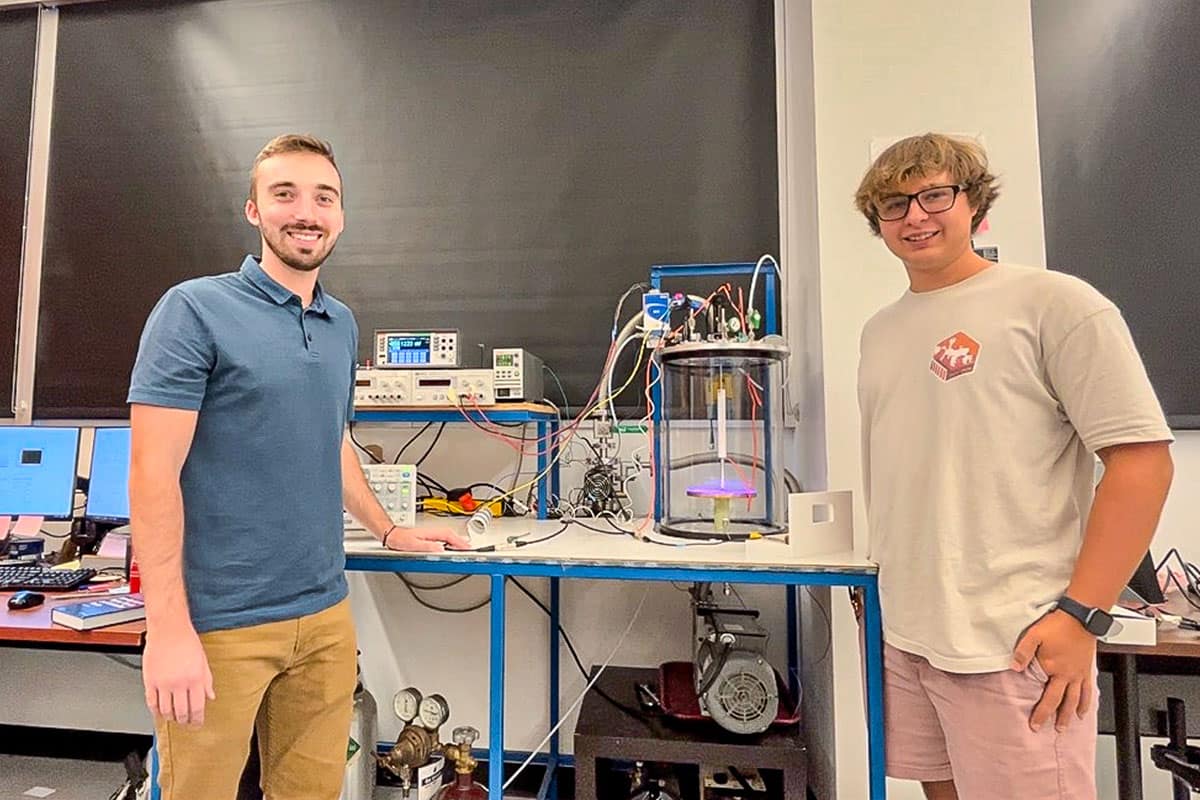Lightning in a Bottle: Embry-Riddle Team Seeks the Origins of Its Spark

Sparking the Next Generation
The NSF grant awarded to Dr. Riousset also includes the creation of a self-guided, open-access course that seeks to prepare learners of all levels to conduct scientific research in planetary sciences, geosciences and astronomy. The course is titled “PyTHAGORA: Python Training for Heliophysics, Astronomy and Geosciences: An OpenCourse for Researchers With Applications.”
Though Benjamin Franklin invented the lightning rod nearly 300 years ago, lightning remains one of nature’s most powerful yet least understood phenomena.
But novel research by Dr. Jeremy A. Riousset and his team at Embry-Riddle Aeronautical University could reveal important clues about how lightning is formed. The research has implications for the safety of power systems, aircraft, rocket launches and even human missions to Mars.
“The very first question we are trying to answer is, ‘How does lightning start?’” said Dr. Riousset, an associate professor of Engineering Physics in Embry‑Riddle’s Physical Sciences Department. This also happens to be one of the most fundamental unanswered questions in the atmospheric sciences.
Lightning is a natural discharge of electricity caused by positive and negative imbalances of electric charges — usually within clouds or between clouds and the ground. “It’s high voltage, it’s a high current, it’s super bright, and it’s super hot,” said Engineering Physics master’s student Jared Nelson, a member of Riousset’s research team.
However, prior to this hot energetic event occurs “a glow,” a lower-voltage discharge that is different from a lightning bolt visible from the ground. This glow was once known to sailors as St. Elmo’s fire: a luminous blue or violet seen on the tops of ships’ masts when storm clouds were overhead.
Measuring the Early Stages of Sparks
Riousset explained that his team aims to measure the exact conditions necessary for the initiation of the glow discharge. The measurements include voltage, pressure and temperature.
To do this, the team has developed an experimental setup for recording data on electrical discharges using a Dusty Plasma Chamber at the Space and Atmospheric Instrumentation Lab (SAIL), part of Embry-Riddle’s Center of Space and Atmospheric Research (CSAR).
The setup allows the team to “not only repeat some experiments but quantify them in a way that has never been done before, providing measurements with exact conditions and margins of error,” Riousset said. The research is being funded by a grant of $442,000 from the National Science Foundation.
The plasma chamber, in effect, creates lightning in a bottle. The system comprises power supplies, pressure meters, pumps, an oscilloscope, a mass flow controller and other equipment. Nelson has created software and electronics to control the system and record its data.
On a recent visit to the lab, Nelson demonstrated the process. First, he pumped out air from the chamber, an 18-inch glass cylinder, to simulate conditions in the higher atmosphere. An electrode at the top of the chamber acts in place of a thundercloud, he explained. Toward the cylinder’s base is a cylindrical plate, a second electrode that acts as the ground.
To initiate the discharges, a direct current is applied, Nelson said. “We keep increasing the voltage, and all of a sudden, now you have your glow discharge.”

A ring of plasma is initiated in the Dusty Plasma Chamber at Embry-Riddle’s SAIL Lab. (Photo: Embry-Riddle/SAIL Lab)
And with that, a violet ring of plasma appeared. The plasma seemed to hover, its luminescence undulating at the edges. Eventually, mini-lightning sparks could be seen.
An innovative element of Embry-Riddle’s setup is how the glow discharge is recorded. With past experiments, researchers had to watch for it. But the discharge, Riousset explained, occurs before the glow becomes visible to the naked eye.
Nelson designed the computer system to record the glow by reading the electrical current. To control the system, he created a string of novel parts, including circuits, sensors and an acquisition box. This required skills ranging from soldering and machining to computer-aided design (CAD), 3D printing, coding and data analysis.
Nelson recently interned with Sidus Space, a company based in Cape Canaveral, Florida, that is at the forefront of developing next-generation space technologies. There, he was part of a team testing electrical systems on satellite payloads. His experience in the SAIL Lab translated well to testing hardware destined for space, he said.
Riousset called his grad student’s inventive approach “very desirable for a company because that means you have someone who is able to see a problem, analyze it and develop their own solution.”
Staying Safe on Earth and Mars
The team’s experiments could have safety implications on Earth — and beyond.
“You have to know what you’re doing because you are working with high-current systems that could be somewhat dangerous,” Nelson said. “But it’s also fun to really understand the driving factors of plasma and to create an experiment around this unique atmospheric phenomenon.”
Riousset said that the electrode’s shape is among the key elements that the team is now testing. The researchers aim to determine which electrode form — pointed, blunt, cylindrical, thin or thick — is most conducive to a discharge. This study of the role of the electrode shape on discharge initiation could ultimately result in “better lightning rod designs,” he said.
“The simple question, ‘What exact shape is the rod supposed to be?’ we don’t know.”
The team is also testing electrical charges in various gas compositions, such as those found on Mars. Atmospheric electricity poses risks to crews and instruments on a mission to the red planet, Riousset explained.
“Our mere presence,” he said, “may create conditions that will favor the creation of electricity.”
